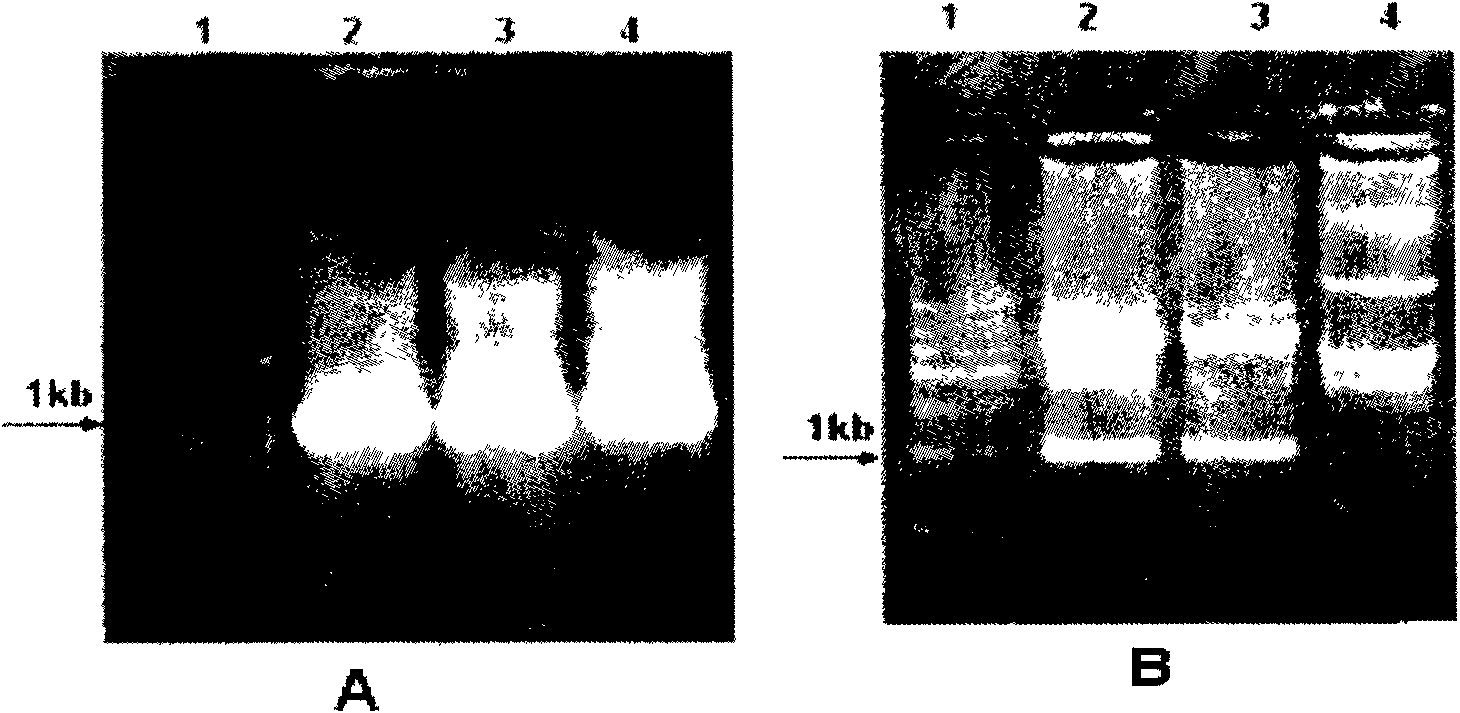Plant expression vector of arabidopsis thaliana cytosolic malate dehydrogenase gene and application thereof
A technology of plant expression vector and malate dehydrogenase, which is applied in application, genetic engineering, plant gene improvement, etc., to improve the ability to resist aluminum toxicity and detoxify the effect
- Summary
- Abstract
- Description
- Claims
- Application Information
AI Technical Summary
Problems solved by technology
Method used
Image
Examples
Embodiment 1
[0046] AMDH gene cDNA amplification and TA cloning:
[0047] First search the full-length gene sequence of AMDH from GenBank, and design a pair of primers, the sequence is as follows:
[0048] AMDH5:5'-CA CCATGG CGAAGGAACCAGTTCGTG-3'
[0049] AMDH3: 5'- CTCGAG TTAAGAGAGGCATGAGTAAGCG-3'
[0050] The CACC characteristic sequence was added to the end of the primer AMDH5 at the 5' end, thereby forming an NcoI restriction site; the end of the primer EMDH3 at the 3' end was added with an XhoI restriction site.
[0051] Use TRIzoL Reagent (Invitrogen) to extract total RNA from Arabidopsis thaliana seedlings, take about 0.1 g of young leaves of the plant, add 1 ml of TRIzoL extract, grind in a mortar, let stand at room temperature for 5 minutes, transfer to a centrifuge tube, and then Add 0.2ml of chloroform, shake and mix, centrifuge for 15min (12000rpm), transfer the supernatant to a new tube, add 0.5ml of isopropanol, mix and place at room temperature for 10min, centrifuge at ...
Embodiment 2
[0053] Construction of Gateway entry cloning vector pENTR*-PrbcS-AMDH of AMDH gene:
[0054] Cut the purified plasmid vector pENTR*-PrbcS-*T-GFP and pUCm-AMDH with NcoI and XhoI ( image 3 ), separated the cut vector and insert by agarose gel electrophoresis, and recovered the vector fragments pENTR*-PrbcS (4.0kb) and pUCm- The DNA fragment (1.0kb) of the AMDH gene generated by cutting AMDH, and then use the ligase kit of TaKaRa to connect the DNA fragment of pENTR*-PrbcS and AMDH gene to generate the entry vector pENTR*-PrbcS-AMDH( image 3 ). Conversion of high efficiency (10 8 ) Escherichia coli competent cells (DH5α, purchased from Tiangen Biochemical Technology Co., Ltd.), spread the transformed Escherichia coli on a plate added with kanamycin (Km, 50 μg / ml), and cultivate overnight at 37 ° C. Screen the Km-resistant recombinant colony, extract the plasmid from the Km-resistant recombinant colony, select the successfully connected plasmid vector pENTR*-PrbcS-AMDH, and ...
Embodiment 3
[0056] Construction of AMDH gene plant expression vector pH2-35S-PrbcS-AMDH:
[0057] PrbcS-AMDH was subcloned into the plant expression vector pH2GW7 (Gateway's destination vector, Belgium VIB / Gent company) by the LR reaction of Gateway technology ( Figure 5 ). The specific method is: use the plasmid extraction kit to purify Gateway’s target vector pH2GW7, add pENTR*-PrbcS-AMDH and pH2GW7 each 150ng, 1μl LR Clonase II Enzyme Mix (Invitrogen) to the LR reaction system of Gateway, and mix well in React overnight at 25°C, and integrate PrbcS-AMDH into pH2GW7 through the action of integrase to obtain the plant expression vector plasmid pH2-35S-PrbcS-AMDH of AMDH ( Figure 5 ). Conversion of high efficiency (10 8 ) Escherichia coli competent cells (DH5α, purchased from Tiangen Biochemical Technology Co., Ltd.), spread the transformed Escherichia coli on a plate added with spectinomycin (Spe, 50 μg / ml), cultivate overnight at 37°C, and screen Spe-resistant recombinant sub-colo...
PUM
 Login to View More
Login to View More Abstract
Description
Claims
Application Information
 Login to View More
Login to View More - R&D
- Intellectual Property
- Life Sciences
- Materials
- Tech Scout
- Unparalleled Data Quality
- Higher Quality Content
- 60% Fewer Hallucinations
Browse by: Latest US Patents, China's latest patents, Technical Efficacy Thesaurus, Application Domain, Technology Topic, Popular Technical Reports.
© 2025 PatSnap. All rights reserved.Legal|Privacy policy|Modern Slavery Act Transparency Statement|Sitemap|About US| Contact US: help@patsnap.com



